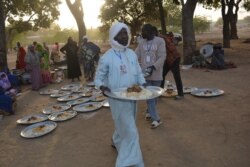The U.N. refugee agency says intercommunal fighting over scarce resources in Cameroon has triggered the mass exodus of more than 30,000 refugees to neighboring Chad.
Deadly clashes erupted December 5 in the Cameroonian border village of Ouloumsa following a dispute between herders, fishermen and farmers over dwindling water resources. Violence then spread to neighboring villages, where intercommunal rivals burned 10 villages to the ground.
The U.N. refugee agency says 22 people have been killed and 30 seriously injured over the past six days. In addition, women and children account for most of the 30,000 refugees who have fled into Chad.
UNHCR spokesman Boris Cheshirkov says the situation remains volatile, forcing his agency to temporarily suspend its operations in the affected areas. He says five staff members, as well as colleagues who have been on an assessment mission, have been moved to the Chadian capital, N'Djamena.
Cheshirkov blames the rising tensions between intercommunal farmers and fishermen on climate change, which he says is getting worse.
"They depend on the waters of the Logone River, which is one of the main tributaries of Lake Chad," he said. "Lake Chad has been shrinking. Over the course of six decades now, it has lost 95 percent of its surface water. These communities rely on that water to live, to fish, to grow crops and cultivate them, to take care of their livestock. They are not able to do this."
Cheshirkov says similar climate crises can be seen in many parts of the world — in the Sahel, in far north Cameroon and East Africa, as well as in the drought corridor of Latin America, and South Asia. He says 90 percent of refugees come from climate vulnerable hotspots.
UNHCR and Cameroonian authorities have been leading reconciliation efforts to end the intercommunal violence, he says, adding that the situation could escalate unless the root causes of the crisis are addressed.
Chad is home to nearly 1 million refugees and internally displaced people, and Cameroon has more than 1.5 million refugees and IDPs. The UNHCR says it has received slightly more than half the money it needs to run its lifesaving operations in both countries. It is appealing to the international community for more support.

